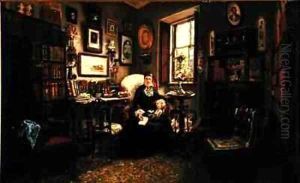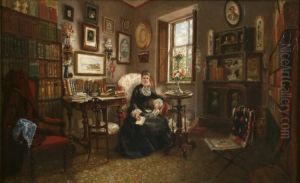Cornelia Adele Strong Fassett Paintings
Cornelia Adele Strong Fassett was an American artist, known primarily for her portraiture and historical paintings. Born on September 9, 1831, in Owasco, New York, she developed an interest in art at an early age. Her family recognized her talent, and she received some of her initial artistic training in her home state. As a young woman, she moved to Chicago, which was a growing center for the arts in the United States during the mid-19th century.
In Chicago, Fassett continued to hone her skills as an artist. She married journalist and publisher Joshua Fassett, who was supportive of her career. The couple moved to Washington, D.C., where Cornelia Fassett would make a name for herself as a portraitist among the political and social elite. During this time, she became well-acquainted with many influential figures of the era, which provided her with numerous subjects for her work.
Cornelia Fassett's most famous painting is 'The Florida Case Before the Electoral Commission,' which she completed in 1879. This large-scale work depicts the United States Electoral Commission of 1877, a body that was created to resolve the disputed presidential election of 1876 between Rutherford B. Hayes and Samuel J. Tilden. The commission consisted of five senators, five members of the House of Representatives, and five Supreme Court justices. Fassett's painting captures this historic event in intricate detail, showcasing her skill in portraiture and her ability to handle complex compositions involving multiple figures.
Throughout her career, Fassett faced the challenges of being a woman artist in a male-dominated field, yet she achieved considerable success. Her works were exhibited at the Centennial Exposition in Philadelphia in 1876 and received positive recognition. She also exhibited her paintings in various art institutions and was involved in the Washington art community, advocating for more visibility and opportunities for women artists.
Cornelia Adele Strong Fassett passed away on December 4, 1898. While she may not be as widely recognized today as some of her contemporaries, her work provides valuable insight into the social and political dynamics of her time and contributes to the understanding of the role of women in the arts during the 19th century.

